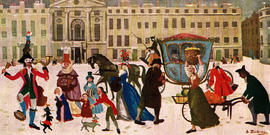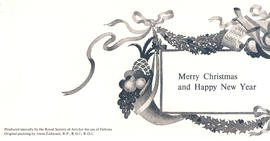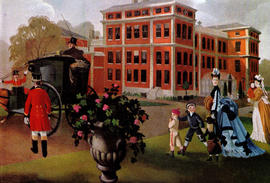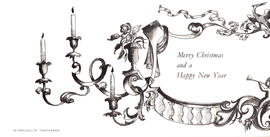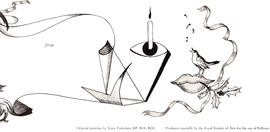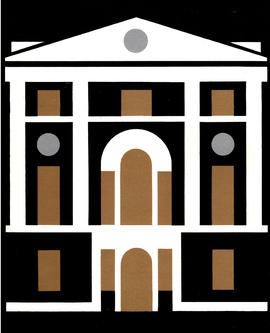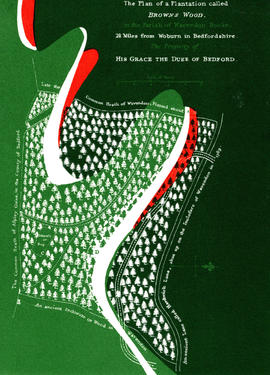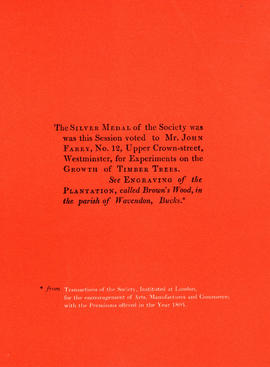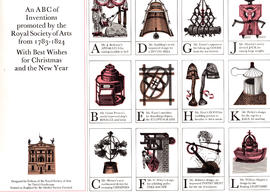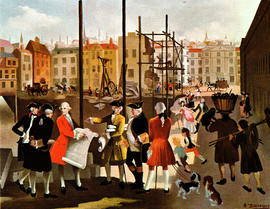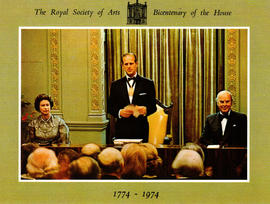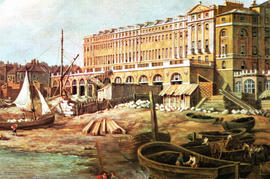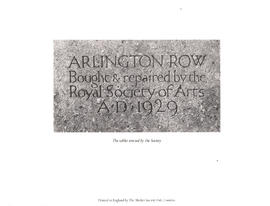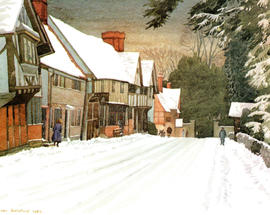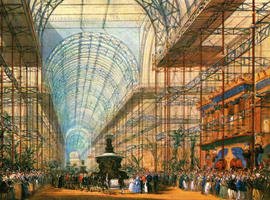HRH The Duke of Edinburgh addressing the Council and Fellows of the RSA in the Great Room on the occasion of the Bicentenary of the House, in the presence of HM The Queen and Sir Brian Batsford, Chairman of Council. 21,000 copies sold
This painting was commissioned from the artist in 1863 by Members' subscriptions as part of the Society's memorial to the Prince Consort's Presidency (1843-1861). Together with a companion portrait of the Prince himself (by C.W. Cope, RA) it was hung in the Great Room. Both pictures remained there until the alterations to the Society's House in 1922-23 when they were removed to their present positions on the main staircase. In Horsley's painting The Queen and her children are shown as they would have been in 1851, the year of the Great Exhibition, which Prince Albert so largely inspired and guided. The young Prince of Wales is holding a plan of the Exhibition building. The other children depicted are (in order of age) The Princess Royal, Princess Alice, Prince Alfred (subsequently Duke of Edinburgh), Princess Helena, Princess Louise and little Prince Arthur (who as Duke of Connaught was to assume the Presidency in 1911). 43,125 copies sold.
Thomas Malton the younger (1748-1804) is best known for his 'Picturesque Tour through the Cities of London and Westminster (1792), etchings of some 100 drawings including a view of the House of the Society of Arts, which had awarded him a premium in 1774, coincidentally, the year of the building's completion. The picture shows on the left, the pedimented block, five lights wide, of what is now No. 18. This, together with the bow fronted building on the right of the picture still survives. But the house next to No. 18, the adjacent, graceful shops and buildings in the Strand, glimpsed at the end of the street, were demolished long ago. The Society did not acquire the freehold of its main house (No. 8) and of the coeval residence for the Secretary (No. 6) until 1922. In December 1977 it purchased the freehold of Nos 4 and 2 and of 18 Adam Street. The Society now owns the largest surviving range of original Adelphi builidngs, all of them designed by Robert and James Adam. The isometric drawing on the back of the card shows the relationship of these various houses. It also indicates the extent of the premises below ground, including huge vaults which extend far beneath John Adam Street. 44,147 copies sold.
Arlington Row dates from the 14th century, originally bult as a wool store it was converted into cottages for weavers in the 17th century. Arlington Row was rescued by the Society during its campaign for the Preservation of Ancient Cottages. In 1927 the owner of the Bibury cottages, unable to keep them, and their beautiful slate roofs, in repair, offered them to the Society for a comparatively small sum. Much more help was needed to repair them but the money was raised through a subscription fund headed by an American James Hazen Hyde. The donor's conditions that the rents should not be raised and that the exisitng tenants remain undisturbed were faithfully kept and in Septmeber 1930 the cottages, fully restored under the direction of Mr P Morley Horder, were formally handed over to the keeping of the Bristol and Gloucestershire Archaeological Trust. In 1949 the property was made over to the National Trust. Speaking at the Annual General Meeting of the campaign in 1929, G K Chesterton described the Society's attitude in saving such ancient dwellings: 'Look, here is a definite creation of man made under more normal, more dignified and more sane social conditions. It is like a Greek temple surviving in an age of barbarians.... This belongs to the history of humanity' Image of the tablet erected by the Society on reverse of card. 59,250 copies sold.
In 1983 Miss Saunders won the British Museum Design Award , sponsored by the Society, for a series of paper cut-out dolls' houses to be sold at the Bethnal Green Museum. 38,181 copies sold.
